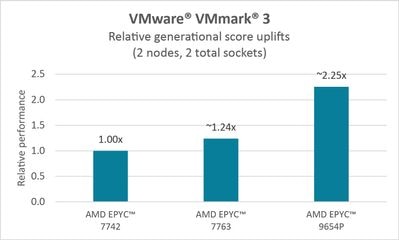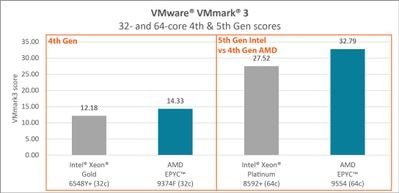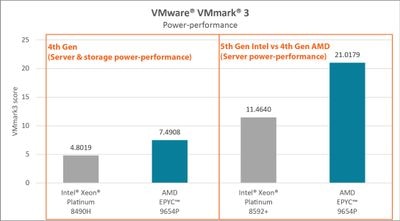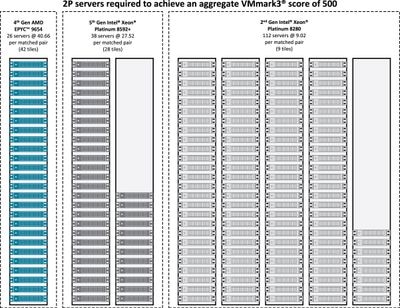4th Gen AMD EPYC™ Processors Continue Performance Dominance for Private Clouds
Jun 19, 2024

AMD EPYC™ processors have emerged as the top choice for private and public cloud deployments since their debut in 2017. 4th Gen AMD EPYC processors feature high core counts, industry-leading x86 memory bandwidth[1], and advanced security features essential for demanding private cloud workloads. AMD EPYC processors along with solutions from VMware® by Broadcom, such as VMware Cloud Foundation (VCF) and VMware vSphere® Foundation (VVF), which include software such as vSphere®, vCenter®, vSAN® and NSX, provide a solid foundation for constructing private cloud infrastructures. The strategic collaboration between AMD and VMware By Broadcom empowers organizations to effectively deploy and manage virtualized environments that fulfill their performance and scalability needs while optimizing energy efficiency and total cost of ownership.
There are two common VCF/VVF deployment scenarios:
- Traditional VVF infrastructure usually entails distinct hardware for compute, storage, and networking. Operating on this model involves overseeing each component separately, often demanding specialized expertise and tools, yet it delivers optimal performance. Software such as VMware vSphere® virtualizes the compute aspect and can be managed by a Virtual Infrastructure Administrator. The storage aspect of this setup relies on dedicated Storage Area Network (SAN) or Network Attached Storage (NAS) systems managed by a Storage Administrator.
- Hyper-Converged Infrastructure (HCI) is a modern approach to data center management that combines compute, storage, and networking into a single, integrated system. HCI solutions typically use Software Defined Storage (SDS), enabled by products such as vSAN®, to pool storage resources across the entire infrastructure for easy scalability and management by a Virtual Infrastructure Administrator. This streamlined approach can optimize costs while improving agility and scalability compared to traditional VCF/VVF setups.






Related Blogs
Footnotes
This blog utilizes VMware By Broadcom’s VMmark benchmark for performance evaluation. With more than 400 publications over the years, VMmark has emerged as a widely accepted standard for assessing the performance of private cloud environments. All performance uplifts shown below are based on the published VMmark scores listed in the appropriate footnote for each uplift.About VMmark®The VMmark® benchmark enables organizations to assess the efficiency and scalability of their virtualized systems by providing comprehensive performance measurements that simulate real-world workloads to evaluate CPU, memory, storage, and networking performance. This holistic view of system capabilities under varying workload conditions enables businesses to make informed decisions regarding hardware configurations, resource allocation, and workload management strategies.VMmark3 uses a weighted scoring system to evaluate a server’s performance by deploying the smallest unit or (“tile”) of load. Each tile consists of nineteen virtual machines that execute a diverse set of workloads running concurrently and collaboratively to represent a typical enterprise virtualization scenario. The static nature of each tile provides a means of sizing and scaling the amount of work for each unique VMmark3 cluster. The number of tiles typically increases as the number of hosts, sockets, and cores increase. Each tile also represents a theoretical maximum score as well as a Quality of Service (QoS) metric to right-size each publication: too few tiles limit the maximum score, and too many tiles violate the benchmark latency requirements.The number of tiles is critical to understanding the capability of a VCF deployment, but application performance is only a portion of the overall score. Typical virtualized deployments also leverage many of the features unique to VCF, such as vMotion, Storage vMotion, XvMotion, and the Distributed Resource Scheduler (DRS). VMmark workloads include the use of these features and provide a more complete picture of what the entire solution can achieve as opposed to a single server. These infrastructure operations can vary in quantity and time-to-completion based on the underlying hardware and therefore contribute 20% of the overall score.Generational Performance GainsAMD remains dedicated to innovation, consistently delivering noteworthy performance and efficiency enhancements for critical workloads. As illustrated in Figure 1, each successive iteration of AMD EPYC processors within VCF environments has yielded substantial performance improvements. These evaluations encompass single-processor and dual-processor configurations, both in standard setups and vSAN configurations. The remarkable performance enhancements achieved with each new generation of AMD EPYC processors underscore the steadfast commitment of AMD to addressing the ever-changing and escalating requirements of modern virtualized infrastructures.[2] Figure 1: Generational VMmark 3 score uplifts - click for larger viewThroughput PerformanceThe previous section of this blog highlighted consistent performance improvements across successive AMD EPYC processor generations, thanks to the ongoing AMD processor technology innovations and joint optimizations with VMware By Broadcom. Figure 2 shows how this unwavering commitment has enabled AMD EPYC processors to maintain performance dominance across multiple processor generations. The 4th Gen AMD EPYC 9654 processor outshines even the latest 5th Gen Intel Xeon Platinum 8592+ processor in VMmark3 performance tested on clusters consisting of two dual-socket servers for a total of four processor sockets.[3]
Figure 1: Generational VMmark 3 score uplifts - click for larger viewThroughput PerformanceThe previous section of this blog highlighted consistent performance improvements across successive AMD EPYC processor generations, thanks to the ongoing AMD processor technology innovations and joint optimizations with VMware By Broadcom. Figure 2 shows how this unwavering commitment has enabled AMD EPYC processors to maintain performance dominance across multiple processor generations. The 4th Gen AMD EPYC 9654 processor outshines even the latest 5th Gen Intel Xeon Platinum 8592+ processor in VMmark3 performance tested on clusters consisting of two dual-socket servers for a total of four processor sockets.[3] Figure 2: Competitive VMmark 3 scores (4 total sockets) - click for larger viewPer-Core PerformancePer-server throughput is an important metric for optimizing server counts, space, and power consumption. Per-core performance is also crucial, particularly for SLA-critical workloads, because this metric often factors significantly in software licensing models based on core count.Figure 3 highlights the performance gains achieved by 32-core AMD EPYC 9374F processors compared to 32-core Intel Xeon Gold 6548Y+ processors, as well as 64-core AMD EPYC 9554 processors versus 64-core 5th Gen Intel Xeon 8592+ processors.[4]
Figure 2: Competitive VMmark 3 scores (4 total sockets) - click for larger viewPer-Core PerformancePer-server throughput is an important metric for optimizing server counts, space, and power consumption. Per-core performance is also crucial, particularly for SLA-critical workloads, because this metric often factors significantly in software licensing models based on core count.Figure 3 highlights the performance gains achieved by 32-core AMD EPYC 9374F processors compared to 32-core Intel Xeon Gold 6548Y+ processors, as well as 64-core AMD EPYC 9554 processors versus 64-core 5th Gen Intel Xeon 8592+ processors.[4] Figure 3: 4th and 5th Gen VMmark3 scores - click for larger viewPower EfficiencyEfficient power consumption is pivotal for modern data centers because this can streamline cooling requirements while optimizing utility costs and contributing to sustainability objectives. Figure 4 shows 4th Gen AMD EPYC 9654 processors delivering superior power efficiency compared to both 4th and 5th Gen Intel Xeon processors [5].
Figure 3: 4th and 5th Gen VMmark3 scores - click for larger viewPower EfficiencyEfficient power consumption is pivotal for modern data centers because this can streamline cooling requirements while optimizing utility costs and contributing to sustainability objectives. Figure 4 shows 4th Gen AMD EPYC 9654 processors delivering superior power efficiency compared to both 4th and 5th Gen Intel Xeon processors [5]. Figure 4: 4th and 5th Gen server power-performance scores - click for larger viewData Center SpaceData centers have strong incentives to optimize how they use their space, power, and cooling to meet sustainability goals and improve TCO. These goals can be realized by using fewer servers that can provide higher VM consolidation, while not compromising on performance needed by business workloads. Let's imagine that we have workloads that require resources and quality of service equivalent to an aggregate VMmark3 score of 500 to meet business goals. As depicted in Figure 5, it only takes 26 servers with 4th Gen AMD EPYC 9654 processors to reach this aggregate score. However, if we use servers with 5th Gen Intel Xeon 8592+ processors, we need 38 servers. Customers with servers using 2nd Gen Intel Xeon 8280 processors may need up to 112 servers to reach the same aggregate score, which is over 4 times the number of AMD EPYC 9654 processor-based servers needed to satisfy the same business workload! This comparison highlights the importance of not just power efficiency but also using server rack space optimally within datacenters.[6]
Figure 4: 4th and 5th Gen server power-performance scores - click for larger viewData Center SpaceData centers have strong incentives to optimize how they use their space, power, and cooling to meet sustainability goals and improve TCO. These goals can be realized by using fewer servers that can provide higher VM consolidation, while not compromising on performance needed by business workloads. Let's imagine that we have workloads that require resources and quality of service equivalent to an aggregate VMmark3 score of 500 to meet business goals. As depicted in Figure 5, it only takes 26 servers with 4th Gen AMD EPYC 9654 processors to reach this aggregate score. However, if we use servers with 5th Gen Intel Xeon 8592+ processors, we need 38 servers. Customers with servers using 2nd Gen Intel Xeon 8280 processors may need up to 112 servers to reach the same aggregate score, which is over 4 times the number of AMD EPYC 9654 processor-based servers needed to satisfy the same business workload! This comparison highlights the importance of not just power efficiency but also using server rack space optimally within datacenters.[6] Figure 5: Number of servers required to achieve an aggregate VMmark3 score of 500 - click for larger viewConclusionThis blog showcased how consistent performance leadership, showcased by VMmark wins, powered by succeeding generations of AMD EPYC processors can provide organizations with unmatched x86 workload performance and optimum hardware consolidation that may also streamline TCO. Organizations can confidently rely on AMD EPYC processors to meet their evolving virtualized infrastructure needs while optimizing power and space requirements. AMD and VMware by Broadcom remain committed to jointly driving innovation that consistently delivers groundbreaking performance and efficiency for virtualized environments. Harnessing the combined expertise of AMD and VMware by Broadcom allows businesses to unlock new levels of agility, scalability, security and reliability in their IT infrastructures.Raghu Nambiar is a Corporate Vice President of Data Center Ecosystems and Solutions for AMD. His postings are his own opinions and may not represent AMD’s positions, strategies or opinions. Links to third party sites are provided for convenience and unless explicitly stated, AMD is not responsible for the contents of such linked sites and no endorsement is implied.Endnotes
Figure 5: Number of servers required to achieve an aggregate VMmark3 score of 500 - click for larger viewConclusionThis blog showcased how consistent performance leadership, showcased by VMmark wins, powered by succeeding generations of AMD EPYC processors can provide organizations with unmatched x86 workload performance and optimum hardware consolidation that may also streamline TCO. Organizations can confidently rely on AMD EPYC processors to meet their evolving virtualized infrastructure needs while optimizing power and space requirements. AMD and VMware by Broadcom remain committed to jointly driving innovation that consistently delivers groundbreaking performance and efficiency for virtualized environments. Harnessing the combined expertise of AMD and VMware by Broadcom allows businesses to unlock new levels of agility, scalability, security and reliability in their IT infrastructures.Raghu Nambiar is a Corporate Vice President of Data Center Ecosystems and Solutions for AMD. His postings are his own opinions and may not represent AMD’s positions, strategies or opinions. Links to third party sites are provided for convenience and unless explicitly stated, AMD is not responsible for the contents of such linked sites and no endorsement is implied.EndnotesEPYC-032B: AMD EPYC 9004 CPUs support 12 channels of up to 4800 MHz DDR5 memory which is 460.8 GB/s of maximum memory throughput per socket. 5th Gen Intel Xeon Scalable/CPU Max supports 8 channels of up to 5600 MHz DDR 5 (per https://ark.intel.com/) have a maximum 358.4 GB/s. EPYC 9004 CPUs have 1.29x the memory throughput per CPU. 460.8 ÷ 358.4 = 1.29x the max throughput or 29% more max throughput.
VMmark® 3.1.1 host/node comparison based on the following published results as of 06/19/2024:
- 2nd Gen EPYC 7742 (9.16 @ 10 tiles) https://www.vmware.com/content/dam/digitalmarketing/vmware/en/pdf/vmmark/2022-02-08-DellEMC-PowerEdge-R7515.pdf - Tested 01/19/2022
- 3rd Gen EPYC 7763 (11.34 @ 12 tiles) https://www.vmware.com/content/dam/digitalmarketing/vmware/en/pdf/vmmark/2022-02-23-DellEMC-PowerEdge-R7515.pdf - Tested 02/16/2022
- 4th Gen EPYC™ 9654P (20.65 @ 21 tiles) https://www.vmware.com/content/dam/digitalmarketing/vmware/en/pdf/vmmark/2023-03-21-Dell-PowerEdge-R7615.pdf - Tested 03/01/2023
VMmark® 3.1.1 host/node comparison based on the following published results as of 06/19/2024:
- Intel Xeon Platinum 8280 (9.02 @ 9 tiles)
https://www.vmware.com/content/dam/digitalmarketing/vmware/en/pdf/vmmark/2019-04-02-Fujitsu-RX2540M5.pdf - Tested 03/09/2019
- 2nd Gen AMD EPYC 7702 (12.78 @ 14 tiles)
https://www.vmware.com/content/dam/digitalmarketing/vmware/en/pdf/vmmark/2019-08-07-HPE-ProLiant-DL385Gen10.pdf - Tested 07/18/2019
- Intel Xeon Platinum 8380 (14.19 @ 14 tiles)
https://www.vmware.com/content/dam/digitalmarketing/vmware/en/pdf/vmmark/2021-04-20-Fujitsu-PRIMERGY-RX2540M6.pdf - Tested 04/05/2021
- 3rd Gen AMD EPYC 7763 (23.33 @ 24 tiles)
https://www.vmware.com/content/dam/digitalmarketing/vmware/en/pdf/vmmark/2022-02-08-Fujitsu-RX2450M1.pdf - Tested 01/20/2022
- Intel Xeon Platinum 8490H (23.38 @ 23 tiles)
https://www.vmware.com/content/dam/digitalmarketing/vmware/en/pdf/vmmark/2023-03-21-Fujitsu-PRIMERGY-RX2540M7.pdf - Tested 03/04/2023
- 4th Gen AMD EPYC 9654 (40.66 @ 42 tiles)
https://www.vmware.com/content/dam/digitalmarketing/vmware/en/pdf/vmmark/2023-06-13-Lenovo-ThinkSystem-SR665V3.pdf - Tested 05/23/2023
- Intel Xeon Platinum 8592+ (27.52 @ 28 tiles)
https://www.vmware.com/content/dam/digitalmarketing/vmware/en/pdf/vmmark/2024-04-16-Fujitsu-PRIMERGY-RX2540M7.pdf
VMmark® 3.1.1 host/node comparison based on the following published results as of 6/19/2024:
- Intel Xeon Gold 6548Y+ (12.18 @ 12 tiles)
https://www.vmware.com/content/dam/digitalmarketing/vmware/en/pdf/vmmark/2024-05-14-Supermicro-SYS-111C-NR.pdf - Tested 04/24/2024
- 4th Gen AMD EPYC 9374F (14.33 @ 16 tiles)
https://www.vmware.com/content/dam/digitalmarketing/vmware/en/pdf/vmmark/2024-04-02-Supermicro-AS-1115CS-TNR.pdf - Tested 03/18/2024
- Intel Xeon Platinum 8592+ (27.52 @ 28 tiles)
https://www.vmware.com/content/dam/digitalmarketing/vmware/en/pdf/vmmark/2024-04-16-Fujitsu-PRIMERGY-RX2540M7.pdf - Tested 04/02/2024
- 4th Gen AMD EPYC 9554 (32.79 @ 32 tiles)
https://www.vmware.com/content/dam/digitalmarketing/vmware/en/pdf/vmmark/2023-11-14-Supermicro-AS-2125HS-TNR.pdf - Tested 10/18/2023
VMmark® 3.1.1 host/node comparison based on the following published results as of 6/19/2024:
- Intel Xeon Platinum 8490H (4.8019 @ 22 tiles)
https://www.vmware.com/content/dam/digitalmarketing/vmware/en/pdf/vmmark/2023-03-21-Fujitsu-PRIMERGY-RX2540M7-serverstoragePPKW.pdf - Tested 03/03/2023
- 4th Gen AMD EPYC 9654P (7.4908 @ 21 tiles)
https://www.vmware.com/content/dam/digitalmarketing/vmware/en/pdf/vmmark/2023-03-21-Dell-PowerEdge-R7615-serverstoragePPKW.pdf - Tested 03/01/2023
- Intel Xeon Platinum 8592+ (11.464 @ 28 tiles)
https://www.vmware.com/content/dam/digitalmarketing/vmware/en/pdf/vmmark/2024-04-30-Fujitsu-PRIMERGY-RX2540-M7-serverPPKW.pdf - Tested 04/06/2024
- 4th Gen AMD EPYC 9654P (21.0179 @ 21 tiles)
https://www.vmware.com/content/dam/digitalmarketing/vmware/en/pdf/vmmark/2023-03-21-Dell-PowerEdge-R7615-serverPPKW.pdf - Tested 03-01-2023
These calculations used the published scores listed in Footnote 3, above. Server requirements were calculated using the formula target_score/(published_per-pair_score/2), which was then rounded up to the next even whole number:
- AMD EPYC 9654: 500/(40.66/2) =500/20.33=~24.59, which was rounded up to 26.
- Intel Xeon Platinum 8592+: 500/(27.52/2)=500/13.76=~36.34, which was rounded up to 38.
- Intel Xeon Platinum 8380: 500/(9.02/2)=500/4.51=~110.86, which was rounded up to 112. vSphere, ESXi, VSAN, Horizon and combinations thereof are trademarks of VMware by Broadcom.
 Figure 1: Generational VMmark 3 score uplifts - click for larger viewThroughput PerformanceThe previous section of this blog highlighted consistent performance improvements across successive AMD EPYC processor generations, thanks to the ongoing AMD processor technology innovations and joint optimizations with VMware By Broadcom. Figure 2 shows how this unwavering commitment has enabled AMD EPYC processors to maintain performance dominance across multiple processor generations. The 4th Gen AMD EPYC 9654 processor outshines even the latest 5th Gen Intel Xeon Platinum 8592+ processor in VMmark3 performance tested on clusters consisting of two dual-socket servers for a total of four processor sockets.[3]
Figure 1: Generational VMmark 3 score uplifts - click for larger viewThroughput PerformanceThe previous section of this blog highlighted consistent performance improvements across successive AMD EPYC processor generations, thanks to the ongoing AMD processor technology innovations and joint optimizations with VMware By Broadcom. Figure 2 shows how this unwavering commitment has enabled AMD EPYC processors to maintain performance dominance across multiple processor generations. The 4th Gen AMD EPYC 9654 processor outshines even the latest 5th Gen Intel Xeon Platinum 8592+ processor in VMmark3 performance tested on clusters consisting of two dual-socket servers for a total of four processor sockets.[3] Figure 2: Competitive VMmark 3 scores (4 total sockets) - click for larger viewPer-Core PerformancePer-server throughput is an important metric for optimizing server counts, space, and power consumption. Per-core performance is also crucial, particularly for SLA-critical workloads, because this metric often factors significantly in software licensing models based on core count.Figure 3 highlights the performance gains achieved by 32-core AMD EPYC 9374F processors compared to 32-core Intel Xeon Gold 6548Y+ processors, as well as 64-core AMD EPYC 9554 processors versus 64-core 5th Gen Intel Xeon 8592+ processors.[4]
Figure 2: Competitive VMmark 3 scores (4 total sockets) - click for larger viewPer-Core PerformancePer-server throughput is an important metric for optimizing server counts, space, and power consumption. Per-core performance is also crucial, particularly for SLA-critical workloads, because this metric often factors significantly in software licensing models based on core count.Figure 3 highlights the performance gains achieved by 32-core AMD EPYC 9374F processors compared to 32-core Intel Xeon Gold 6548Y+ processors, as well as 64-core AMD EPYC 9554 processors versus 64-core 5th Gen Intel Xeon 8592+ processors.[4] Figure 3: 4th and 5th Gen VMmark3 scores - click for larger viewPower EfficiencyEfficient power consumption is pivotal for modern data centers because this can streamline cooling requirements while optimizing utility costs and contributing to sustainability objectives. Figure 4 shows 4th Gen AMD EPYC 9654 processors delivering superior power efficiency compared to both 4th and 5th Gen Intel Xeon processors [5].
Figure 3: 4th and 5th Gen VMmark3 scores - click for larger viewPower EfficiencyEfficient power consumption is pivotal for modern data centers because this can streamline cooling requirements while optimizing utility costs and contributing to sustainability objectives. Figure 4 shows 4th Gen AMD EPYC 9654 processors delivering superior power efficiency compared to both 4th and 5th Gen Intel Xeon processors [5]. Figure 4: 4th and 5th Gen server power-performance scores - click for larger viewData Center SpaceData centers have strong incentives to optimize how they use their space, power, and cooling to meet sustainability goals and improve TCO. These goals can be realized by using fewer servers that can provide higher VM consolidation, while not compromising on performance needed by business workloads. Let's imagine that we have workloads that require resources and quality of service equivalent to an aggregate VMmark3 score of 500 to meet business goals. As depicted in Figure 5, it only takes 26 servers with 4th Gen AMD EPYC 9654 processors to reach this aggregate score. However, if we use servers with 5th Gen Intel Xeon 8592+ processors, we need 38 servers. Customers with servers using 2nd Gen Intel Xeon 8280 processors may need up to 112 servers to reach the same aggregate score, which is over 4 times the number of AMD EPYC 9654 processor-based servers needed to satisfy the same business workload! This comparison highlights the importance of not just power efficiency but also using server rack space optimally within datacenters.[6]
Figure 4: 4th and 5th Gen server power-performance scores - click for larger viewData Center SpaceData centers have strong incentives to optimize how they use their space, power, and cooling to meet sustainability goals and improve TCO. These goals can be realized by using fewer servers that can provide higher VM consolidation, while not compromising on performance needed by business workloads. Let's imagine that we have workloads that require resources and quality of service equivalent to an aggregate VMmark3 score of 500 to meet business goals. As depicted in Figure 5, it only takes 26 servers with 4th Gen AMD EPYC 9654 processors to reach this aggregate score. However, if we use servers with 5th Gen Intel Xeon 8592+ processors, we need 38 servers. Customers with servers using 2nd Gen Intel Xeon 8280 processors may need up to 112 servers to reach the same aggregate score, which is over 4 times the number of AMD EPYC 9654 processor-based servers needed to satisfy the same business workload! This comparison highlights the importance of not just power efficiency but also using server rack space optimally within datacenters.[6] Figure 5: Number of servers required to achieve an aggregate VMmark3 score of 500 - click for larger viewConclusionThis blog showcased how consistent performance leadership, showcased by VMmark wins, powered by succeeding generations of AMD EPYC processors can provide organizations with unmatched x86 workload performance and optimum hardware consolidation that may also streamline TCO. Organizations can confidently rely on AMD EPYC processors to meet their evolving virtualized infrastructure needs while optimizing power and space requirements. AMD and VMware by Broadcom remain committed to jointly driving innovation that consistently delivers groundbreaking performance and efficiency for virtualized environments. Harnessing the combined expertise of AMD and VMware by Broadcom allows businesses to unlock new levels of agility, scalability, security and reliability in their IT infrastructures.Raghu Nambiar is a Corporate Vice President of Data Center Ecosystems and Solutions for AMD. His postings are his own opinions and may not represent AMD’s positions, strategies or opinions. Links to third party sites are provided for convenience and unless explicitly stated, AMD is not responsible for the contents of such linked sites and no endorsement is implied.Endnotes
Figure 5: Number of servers required to achieve an aggregate VMmark3 score of 500 - click for larger viewConclusionThis blog showcased how consistent performance leadership, showcased by VMmark wins, powered by succeeding generations of AMD EPYC processors can provide organizations with unmatched x86 workload performance and optimum hardware consolidation that may also streamline TCO. Organizations can confidently rely on AMD EPYC processors to meet their evolving virtualized infrastructure needs while optimizing power and space requirements. AMD and VMware by Broadcom remain committed to jointly driving innovation that consistently delivers groundbreaking performance and efficiency for virtualized environments. Harnessing the combined expertise of AMD and VMware by Broadcom allows businesses to unlock new levels of agility, scalability, security and reliability in their IT infrastructures.Raghu Nambiar is a Corporate Vice President of Data Center Ecosystems and Solutions for AMD. His postings are his own opinions and may not represent AMD’s positions, strategies or opinions. Links to third party sites are provided for convenience and unless explicitly stated, AMD is not responsible for the contents of such linked sites and no endorsement is implied.Endnotes- 2nd Gen EPYC 7742 (9.16 @ 10 tiles) https://www.vmware.com/content/dam/digitalmarketing/vmware/en/pdf/vmmark/2022-02-08-DellEMC-PowerEdge-R7515.pdf - Tested 01/19/2022
- 3rd Gen EPYC 7763 (11.34 @ 12 tiles) https://www.vmware.com/content/dam/digitalmarketing/vmware/en/pdf/vmmark/2022-02-23-DellEMC-PowerEdge-R7515.pdf - Tested 02/16/2022
- 4th Gen EPYC™ 9654P (20.65 @ 21 tiles) https://www.vmware.com/content/dam/digitalmarketing/vmware/en/pdf/vmmark/2023-03-21-Dell-PowerEdge-R7615.pdf - Tested 03/01/2023
- Intel Xeon Platinum 8280 (9.02 @ 9 tiles)
https://www.vmware.com/content/dam/digitalmarketing/vmware/en/pdf/vmmark/2019-04-02-Fujitsu-RX2540M5.pdf - Tested 03/09/2019
- 2nd Gen AMD EPYC 7702 (12.78 @ 14 tiles)
https://www.vmware.com/content/dam/digitalmarketing/vmware/en/pdf/vmmark/2019-08-07-HPE-ProLiant-DL385Gen10.pdf - Tested 07/18/2019
- Intel Xeon Platinum 8380 (14.19 @ 14 tiles)
https://www.vmware.com/content/dam/digitalmarketing/vmware/en/pdf/vmmark/2021-04-20-Fujitsu-PRIMERGY-RX2540M6.pdf - Tested 04/05/2021
- 3rd Gen AMD EPYC 7763 (23.33 @ 24 tiles)
https://www.vmware.com/content/dam/digitalmarketing/vmware/en/pdf/vmmark/2022-02-08-Fujitsu-RX2450M1.pdf - Tested 01/20/2022
- Intel Xeon Platinum 8490H (23.38 @ 23 tiles)
https://www.vmware.com/content/dam/digitalmarketing/vmware/en/pdf/vmmark/2023-03-21-Fujitsu-PRIMERGY-RX2540M7.pdf - Tested 03/04/2023
- 4th Gen AMD EPYC 9654 (40.66 @ 42 tiles)
https://www.vmware.com/content/dam/digitalmarketing/vmware/en/pdf/vmmark/2023-06-13-Lenovo-ThinkSystem-SR665V3.pdf - Tested 05/23/2023
- Intel Xeon Platinum 8592+ (27.52 @ 28 tiles)
https://www.vmware.com/content/dam/digitalmarketing/vmware/en/pdf/vmmark/2024-04-16-Fujitsu-PRIMERGY-RX2540M7.pdf
- Intel Xeon Gold 6548Y+ (12.18 @ 12 tiles)
https://www.vmware.com/content/dam/digitalmarketing/vmware/en/pdf/vmmark/2024-05-14-Supermicro-SYS-111C-NR.pdf - Tested 04/24/2024
- 4th Gen AMD EPYC 9374F (14.33 @ 16 tiles)
https://www.vmware.com/content/dam/digitalmarketing/vmware/en/pdf/vmmark/2024-04-02-Supermicro-AS-1115CS-TNR.pdf - Tested 03/18/2024
- Intel Xeon Platinum 8592+ (27.52 @ 28 tiles)
https://www.vmware.com/content/dam/digitalmarketing/vmware/en/pdf/vmmark/2024-04-16-Fujitsu-PRIMERGY-RX2540M7.pdf - Tested 04/02/2024
- 4th Gen AMD EPYC 9554 (32.79 @ 32 tiles)
https://www.vmware.com/content/dam/digitalmarketing/vmware/en/pdf/vmmark/2023-11-14-Supermicro-AS-2125HS-TNR.pdf - Tested 10/18/2023
- Intel Xeon Platinum 8490H (4.8019 @ 22 tiles)
https://www.vmware.com/content/dam/digitalmarketing/vmware/en/pdf/vmmark/2023-03-21-Fujitsu-PRIMERGY-RX2540M7-serverstoragePPKW.pdf - Tested 03/03/2023
- 4th Gen AMD EPYC 9654P (7.4908 @ 21 tiles)
https://www.vmware.com/content/dam/digitalmarketing/vmware/en/pdf/vmmark/2023-03-21-Dell-PowerEdge-R7615-serverstoragePPKW.pdf - Tested 03/01/2023
- Intel Xeon Platinum 8592+ (11.464 @ 28 tiles)
https://www.vmware.com/content/dam/digitalmarketing/vmware/en/pdf/vmmark/2024-04-30-Fujitsu-PRIMERGY-RX2540-M7-serverPPKW.pdf - Tested 04/06/2024
- 4th Gen AMD EPYC 9654P (21.0179 @ 21 tiles)
https://www.vmware.com/content/dam/digitalmarketing/vmware/en/pdf/vmmark/2023-03-21-Dell-PowerEdge-R7615-serverPPKW.pdf - Tested 03-01-2023
- AMD EPYC 9654: 500/(40.66/2) =500/20.33=~24.59, which was rounded up to 26.
- Intel Xeon Platinum 8592+: 500/(27.52/2)=500/13.76=~36.34, which was rounded up to 38.
- Intel Xeon Platinum 8380: 500/(9.02/2)=500/4.51=~110.86, which was rounded up to 112.








